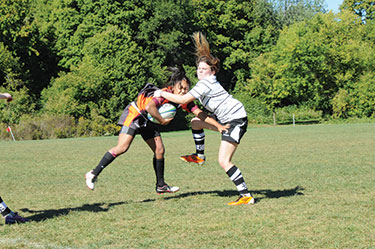By: Britnei Bilhete
A referee blows his whistle to end a Humber-Sheridan women’s rugby sevens match at the OCAA’s very first season opener. “That’s it?” one spectator says to another. “Yep,” she responds “if you blink, you’ll miss it.”
Unlike the traditional game of rugby that lasts 80 minutes long, sevens is much quicker as it consists of two seven-minute halves, while the other major difference is the number of players on each team; seven compared to 15 respectively. Seneca’s pivot Sarah Givens said she loved the new sport just moments after her first game. “You can give your all for seven minutes,” she said happily. “I’ve never played before so it’s exciting.”
Sevens’ fast and physical spirit seems to have contributed to its recent popularity boost on an international level. This summer in Rio, rugby sevens made its Olympic debut. In 2015 at the Pan Am Games hosted in Toronto, women’s rugby sevens was introduced to the program for the first time. Now, the OCAA is following suit.
“From the OCAA’s perspective [we were] trying to determine a sport we can especially get female participation in,” says OCAA vice-president of programs Wayne Fish. “There doesn’t seem to be as many club programs for women’s rugby and so this seems to be a sport that is growing very quickly … [and] at the high school level as well.”
Many women’s rugby teams within the OCAA were scrambling to rally a typical team of 30. It was especially difficult to find participation at schools that emphasized arts-based programs, such as Sheridan College where Tamara Dixon coaches the women’s rugby team and Fish also acts as varsity sport coordinator. “With fifteens there’s a struggle to get 30 players out,” says Dixon. “When you have girls with responsibilities with their co-op placements or their work responsibilities or their family responsibilities, they can’t make the weekday games and then you’re running short to a game.” Worst case scenario: “You might be going into a game with 19 players.” Fewer athletes on hand means fewer substitutions when others are fatigued or injured.
Dixon, who is a former rugby sevens player, says she appreciates the introduction firstly because a faster game means less contact which ‘means less opportunity for injury’. Although her reasoning seems logical, it may be, unfortunately, theoretical.
According to a British Journal of Sports Medicine study, researchers discovered an interesting find. While watching England’s women’s rugby sevens Squad during the 2014 World Cup, they found ‘match injury incidence in this small cohort was higher than in women’s fifteens’. The number of injuries that occurred during practices were also higher.
Though Fish says it’s still too early to tell what kind of injury trends there will be in the OCAA’s sevens league, during fifteens regular season of this year Loyalist college withdrew from the competition because of, what a post on their website indicates, a string of serious injuries within the team. Safety was the main reason the team folded; which was compromised in in part by the numbers of players on the team – only 18 out of 30 positions were filled.

For the fifteens season champions Fleming Knights, Loyalists drop out meant less competition for them. And that left them feeling frustrated. “It does feel better knowing that you defeated the whole OCAA rather than just the half that decided to play fifteens,” says Knights rugby coach Shannon Burton.
Since there was only three contenders at the championship game, every team medalled. Fleming was awarded an OCAA medal for a fourth-straight season. But this win didn’t sit like the others.
“Humber always had a strong program,” says Burton. “If they had put together a fifteens team some say maybe they would have beat us. There’s that thought ‘You didn’t beat everyone.’”
In fifteens defence, Burton says her team stuck with the traditional choice because “fifteens allows a larger variety of players to participate. When you go down to sevens there’s a type of player you’re cutting that opportunity out for.”
Dixon agrees it is a different game. “So a lot of the girls are experiencing more high intense running than in fifteens where it’s run, go, run, go, run go.” She says many of the fifteens players would struggle with the transition.
“For sevens, for the crowd, it’s a better game to watch. It’s more
entertaining.”
The rugby sevens season wrapped up with Humber’s women taking gold.

